|
Early last week, Typhoon Nida raided Hong Kong. We received three reports of flooding, one report of landslide and some 400 reports of fallen trees. Luckily, Nida did not result in any major damage and casualties in Hong Kong. I would like to thank the on-duty frontline staff from various departments for their dedicated services to the public during the typhoon.
That this typhoon did not cause too much damage to Hong Kong can be attributed to several factors, such as wind force, rainfall and where the typhoon landed. In addition, our works departments have been working hard on infrastructure projects to defend against various disasters over the years, and the preparation made before the wet season every year have also equipped Hong Kong with considerable resilience to withstand disasters that rainstorms may lead to.
In fact, a city’s resilience against natural disasters is like the human immune system. When we are healthy, we may not be aware of what our immune system has done to defend against bacterial infection and diseases. In Hong Kong, while the public may not notice the Government’s extensive work behind the scenes on flood prevention infrastructure, slope safety and tree management over the years, these measures have indeed helped us get through many rainstorms relatively unscathed over the years. Over the past decades, the number of serious incidents and casualties due to bad weather has continued to decline, and remained at a very low level. If we take a look around the world and some of our neighbouring regions, we can often see how much havoc adverse weather conditions can wreak. It also reminds us that we should not take a city’s resilience against natural disasters for granted, and that we have to plan ahead. Let me briefly introduce the disaster mitigation measures of the relevant works departments and their preparation in response to future climate change.
Flood prevention works
Over the past 20 years, the Drainage Services Department has completed more than 100 kilometres of river training works and 27 village flood pumping schemes in total, which have greatly reduced flooding risks in the rural areas of the New Territories. For some older urban areas, it is not easy to enhance the existing old standard drainage system due to heavy road traffic. We have thus adopted more innovative options for drainage interception and flood storage by constructing four drainage tunnels of four to seven metres in diameter and about 21 kilometres long in total in Tsuen Wan, Lai Chi Kok, Kai Tak and Hong Kong West; and three underground stormwater storage tanks, with a total capacity of nearly 170 000 cubic metres (equivalent to approximately 68 standard swimming pools), in Tai Hang Tung, Sheung Wan and Happy Valley to alleviate flooding risks in a number of old urban areas. These projects have enhanced the flood prevention capability of Hong Kong in general to ensure public safety. Moreover, with reference to the global trend in recent years, we are actively taking forward the “sponge city” concept, which aims to imitate the natural environment and reduce surface runoffs by promoting penetration with the use of porous pavements. Storage ponds (such as the one proposed on the Anderson Road) and riverside parks will also be used for flood storage and retardation, so as to store some of the rainwater during rainstorms to reduce the peak flow and alleviate the flooding problem.
Slope safety
The Geotechnical Engineering Office (GEO) of the Civil Engineering and Development Department has developed a comprehensive slope safety system to reduce landslide risks with multi-pronged strategies. The overall landslide risks of man-made slopes in Hong Kong has been substantially reduced to 25 per cent of the risk level in 1977, which is commensurate with the international best practice in risk management. Since the launch of the Landslip Prevention and Mitigation Programme in 2010, the GEO has been adopting risk-based strategies to systematically manage 150 government man-made slopes and mitigate the landslide risks of 30 natural hillsides every year. However, although we have lowered the landslide risks to as low a level as reasonably practicable, it is still impossible to attain “zero risks”. Massive landslides may still happen under the influence of climate change and extreme weather conditions. Therefore, we have implemented various measures in recent years to enhance our emergency preparedness against extreme weather conditions. In addition, we aim to raise public awareness of possible landslide risks under extreme weather conditions and enhance the community’s preparedness against risks and disasters through public education and information dissemination.
Tree management
The Government adopts an integrated approach in managing trees on government land. The departments concerned conduct regular inspection of trees under their maintenance in accordance with the relevant policies and guidelines formulated by the Tree Management Office. Before the onset of the wet season every year, the departments will also carry out risk assessments of trees under their purview at locations with high pedestrian or vehicular flow. Appropriate follow-up actions will be taken once changes in the risk situation of a particular tree have been identified. However, it is inevitable that some trees will still be blown over by strong winds during rainstorms. Government departments will do their best so as to promptly remove fallen trees and other obstacles, with a view to re-opening blocked roads and maintaining traffic flow as soon as possible.
Plan ahead for climate change
Looking ahead, we will refer to the assessment of the United Nation’s Intergovernmental Panel on Climate Change in tackling the challenges brought about by climate change. In particular, changes in rainfall and the rise in sea level will be closely monitored and the design standards of Hong Kong’s infrastructure will be updated in a timely manner according to actual circumstances. At the same time, we will review and appropriately upgrade the existing infrastructure’s capacity to defend against disasters brought about by climate change. For instance, flood protection walls may have to be installed at major sewage treatment facilities along the coastline to prevent damage during torrential rain.
Moreover, we will maintain regular communication with public utility undertakers like the MTRC and tunnel companies, and devise contingency plans. Even under extremely inclement weather conditions, the city can quickly resume operation and will not be paralysed for too long, so as to minimise the impact on the public.
“Rome wasn’t built in a day.” Hong Kong’s resilience against disasters today is the result of the tremendous effort of our predecessors, and has won acclaim from many of our neighbouring regions. We also have to keep abreast of the times to further enhance our capability and flexibility in light of the challenges of climate change. I hope the public will continue to support our work.
|
|
|
|
| The drainage tunnel located underneath the Lai Chi Kok urban area |
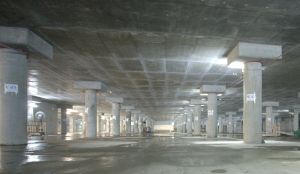 |
| The interior of the underground stormwater storage tank in Happy Valley |
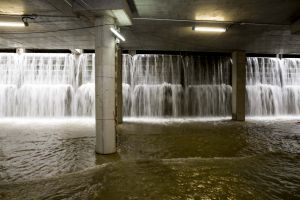 |
| The interior of the stormwater storage tank with floodgates opened |
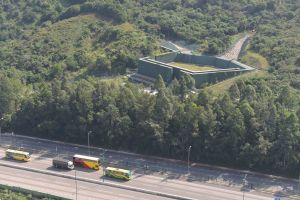 |
| The debris flow barrier at the side of North Lantau Highway |
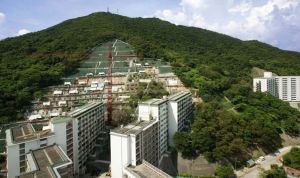 |
| The slope upgrading works at Sai Wan Estate |
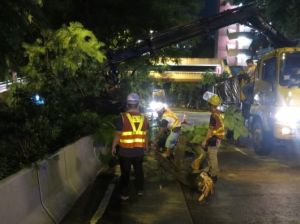 |
| Frontline colleagues from various departments removing fallen trees as quickly as possible to re-open obstructed roads after rainstorms |
|